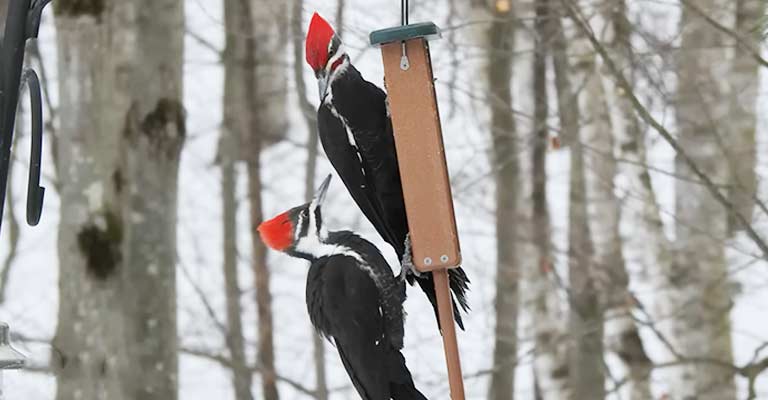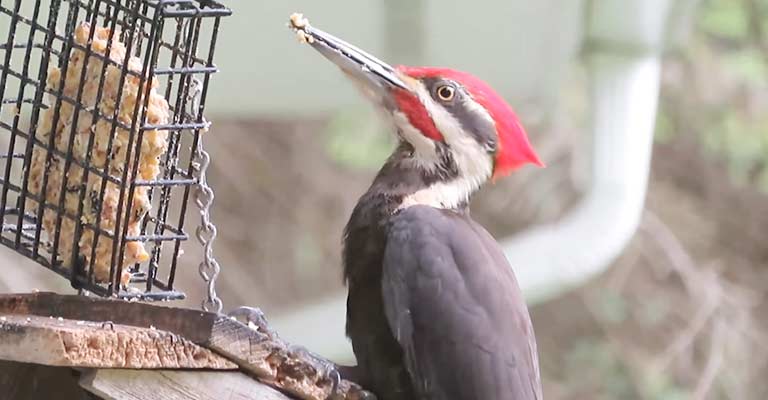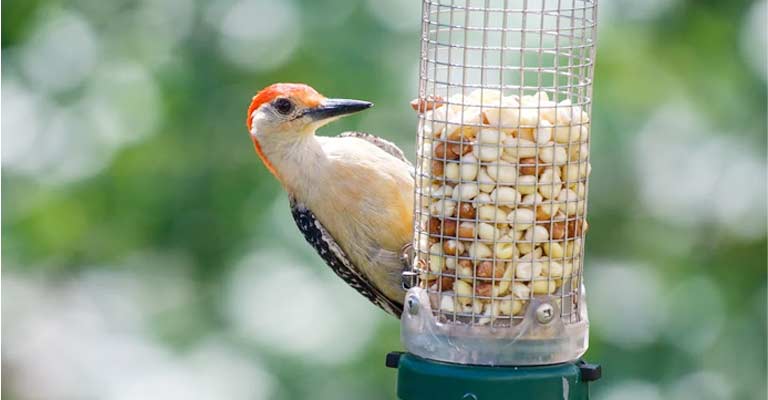Welcoming the striking presence of Pileated Woodpeckers into your outdoor space requires a thoughtful orchestration of their habitat and feeding preferences.
These majestic birds, with their vibrant plumage and distinctive calls, can be enticed by understanding their unique needs.
From choosing the right food sources to creating a woodpecker-friendly environment, the art of attracting Pileated Woodpeckers involves a harmonious blend of natural elements.
Explore how to attract pileated Woodpeckers to not only witness these magnificent woodpeckers up close but also contribute to the conservation of their species.

How To Attract Pileated Woodpeckers?
Attracting the majestic Pileated Woodpeckers to your outdoor space requires a thoughtful approach that considers their unique preferences.
From providing suitable feeding stations to creating an inviting habitat, here are some effective ways to attract these iconic woodpeckers to your vicinity.
Suet Feeders
Pileated Woodpeckers are particularly fond of suet, a high-energy food source. Hanging suet feeders filled with quality suet cakes, especially those containing insects, berries, or nuts, can entice these woodpeckers to visit your backyard.
Mealworms and Insects
Offering live or dried mealworms and a variety of insects caters to the Pileated Woodpeckers’ insectivorous diet. Incorporating these protein-rich options into your feeding setup can attract these birds seeking a natural and nourishing meal.
Tall, Mature Trees
Pileated Woodpeckers favor habitats with tall, mature trees, as they often excavate nest cavities in such settings. Preserving or planting large trees in your yard provides both shelter and nesting opportunities, making your space more appealing to these woodpeckers.
Dead Trees or Snags
Dead trees, also known as snags, are attractive to Pileated Woodpeckers for foraging and nesting. Leaving dead trees standing in your yard or installing man-made nest boxes mimicking snag conditions can serve as enticing features for these birds.
Providing Water Sources
Pileated Woodpeckers, like many birds, are drawn to water sources for drinking and bathing. Installing bird baths or shallow containers of water in your yard provides a crucial element to entice these woodpeckers, especially during warmer seasons.
Insect-Friendly Landscaping
Create an insect-friendly environment by incorporating native plants that attract insects, a primary food source for Pileated Woodpeckers. Maintaining a diverse and natural landscape can support the woodpeckers’ foraging needs.
Minimal Use of Pesticides
Minimize the use of pesticides in your yard to encourage a healthy insect population, which serves as a natural food source for Pileated Woodpeckers. A pesticide-free environment ensures a more inviting habitat for these birds.
Eating Habits Of A Pileated Woodpecker

The Pileated Woodpecker, with its striking appearance and vibrant plumage, has distinct eating habits shaped by its insectivorous nature and foraging techniques.
Understanding these habits can enhance efforts to attract and appreciate these majestic birds in their natural environment.
Insect Foraging
Pileated Woodpeckers primarily feed on insects found beneath the bark of trees. Using their powerful bills, they excavate wood to uncover ants, beetles, larvae, and other invertebrates, displaying remarkable precision in foraging.
Sap Extraction
An intriguing eating habit involves extracting sap from trees. Pileated Woodpeckers create sapwells by pecking into the bark, accessing the nutrient-rich sap. This behavior not only provides sustenance but also showcases their adaptability in utilizing diverse food sources.
Fruit and Berry Consumption
Pileated Woodpeckers incorporate fruits and berries into their diet, especially during the non-breeding season. They forage on the branches of trees for berries, adding variety to their meals and contributing to the overall balance of their diet.
Nuts and Seeds
Mast crops, including acorns, beech nuts, and pine seeds, are part of the Pileated Woodpecker’s diet. Their strong bills are adept at extracting nuts and seeds from various tree species, offering a source of fats and calories.
Wood-Boring Insects
Pileated Woodpeckers target wood-boring insects residing in decaying wood. Their keen ability to locate and extract these insects contributes to the bird’s role in controlling insect populations, demonstrating an ecological impact through their eating habits.
Excavating Fungi and Mushrooms
Fungi and mushrooms growing on decaying wood become an additional dietary choice for Pileated Woodpeckers. They peck into the wood to expose and consume these fungal growths, showcasing a level of culinary diversity in their foraging habits.
Spider Webs and Egg Masses
Pileated Woodpeckers exhibit a unique eating habit by targeting spider webs and egg masses. This behavior provides a protein boost to their diet, underlining their resourcefulness in diversifying their food sources when needed.
Where Is The Best Place To Hang A Woodpecker Feeder?

Creating an inviting space for woodpeckers involves strategic placement of feeders to mimic their natural foraging habits. By considering various locations, you can enhance the chances of attracting these captivating birds to your feeder.
Here are some ideal places to hang a woodpecker feeder:
Near Mature Trees
Hanging a woodpecker feeder near mature trees provides a familiar environment for these birds. Woodpeckers often forage on tree trunks and branches, so placing a feeder in proximity allows them to seamlessly transition between natural and artificial food sources.
On a Sturdy Pole
Mounting a feeder on a sturdy pole helps mimic the stability of tree trunks. Woodpeckers, with their powerful bills, appreciate a stable surface. Ensure the pole is tall enough to deter predators and positioned away from potential launching points for predators like squirrels.
Close to Suet Stations
Woodpeckers have a particular affinity for suet, making feeders with suet cakes attractive to them. Place a suet feeder near your main bird feeder station to accommodate these birds’ preferences and provide them with a protein-rich food source.
In a Shaded Area
Woodpeckers often prefer feeding in shaded areas, especially during warmer seasons. Positioning the feeder in a shaded spot helps create a comfortable environment, encouraging these birds to visit more frequently, particularly during midday when shade is appreciated.
Away from High Traffic Areas
To minimize disturbance and ensure a safe feeding environment, avoid placing woodpecker feeders in high-traffic areas. Choose a spot where the birds can feed undisturbed, fostering a sense of security that encourages regular visits.
Near Water Sources
Woodpeckers, like many birds, appreciate water sources for drinking and bathing. Placing a feeder near a bird bath or other water feature enhances the appeal of your feeding station, providing a holistic and attractive habitat for these birds.
In a Quiet Corner
Opt for a quiet corner in your yard to hang a woodpecker feeder. Woodpeckers appreciate peace and solitude while feeding, and choosing a less busy location reduces the likelihood of disturbances that might deter them from frequenting the feeder.
By strategically placing woodpecker feeders in these locations, you create an environment that mirrors their natural foraging patterns, increasing the likelihood of these remarkable birds gracing your outdoor space with their presence.
FAQs
What types of feeders do Pileated Woodpeckers prefer?
Pileated Woodpeckers favor suet feeders filled with quality suet cakes containing insects, berries, or nuts. Consider incorporating mealworm and nut feeders to diversify their food options.
Can I attract Pileated Woodpeckers with a bird bath?
Yes, Pileated Woodpeckers appreciate water sources. Placing a bird bath or shallow container of water near feeders creates an inviting environment, enhancing the appeal of your backyard.
Do Pileated Woodpeckers prefer certain trees for nesting?
Pileated Woodpeckers favor mature trees for nesting. Preserving or planting tall trees with suitable nesting conditions, such as dead trees or snags, provides an attractive environment.
How do I minimize disturbances while attracting Pileated Woodpeckers?
Place feeders away from high-traffic areas to minimize disturbances. Select a quiet corner in your yard to create a serene feeding environment, encouraging these birds to visit undisturbed.
Can Pileated Woodpeckers be attracted to insect-friendly landscaping?
Yes, incorporating native plants that attract insects supports Pileated Woodpeckers’ foraging needs. Maintain a diverse and natural landscape to provide an additional food source for these birds.
Conclusion
In the quiet moments of nature, the successful attraction of Pileated Woodpeckers unveils a tapestry of mindful efforts.
By catering to their dietary preferences, providing suitable nesting opportunities, and mimicking their natural foraging habitats, you’ve created a haven for these iconic birds.
The rewards extend beyond the visual delight of observing them; it becomes a testament to the delicate balance achieved when human spaces harmonize with the needs of the wild.
The flight of a Pileated Woodpecker to your backyard is not merely a visitation; it’s an affirmation of a shared space where nature and admiration coalesce.